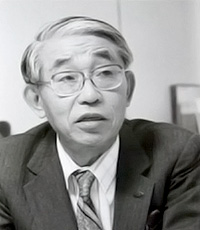Japanese Pioneers
Tadashi Sasaki

Tadashi Sasaki was born in Shimane Prefecture in 1915. After graduating from the Electrical Engineering Department at Kyoto Imperial University in 1938, he joined Kawanishi Machine Works, Ltd. (later renamed Kobe Industries Corporation, and now Fujitsu Limited) where he was engaged in research into and production of vacuum tubes. He was involved in radar research during World War II. He moved to Hayakawa Electric Industry Co., Ltd. (presently Sharp Corporation) in 1964, and there took the initiative in developing electronic calculators. After serving as a senior managing director and executive vice president, he became a corporate advisor. In 1994, he founded the International Center for Materials Research as a representative director. The IEEE awarded him Honorary Membership in 2003 (and he became only the fifth person to receive this in Japan).
He moved from Kobe Industries Corporation to Sharp at the request of the top management of Sharp in 1964 when Sharp Corporation was developing the world’s first fully-transistorized calculator. Thereafter, he took the lead in promoting technological innovation in the calculator development race, and succeeded in developing an IC-based calculator within two years. Furthermore, in collaboration with North American Rockwell, Sharp placed the world’s first LSI-circuit-based calculator (the QT-8D microCompet) on the market in 1969. This product had an enormous impact on the calculator business and on the semiconductor industry in general, since it provided a strong driving force for the application of LSIs in other electronic devices.
Sasaki continued his search for the ultimate technology by working on the development of calculators based on CMOS logic and liquid crystal displays, and succeeded in developing these to the mass production stage in 1973. This marvelous achievement came less than ten years after introduction of the first products based on germanium transistors, and its success owed an extensive debt to Sasaki’s foresight and leadership.


